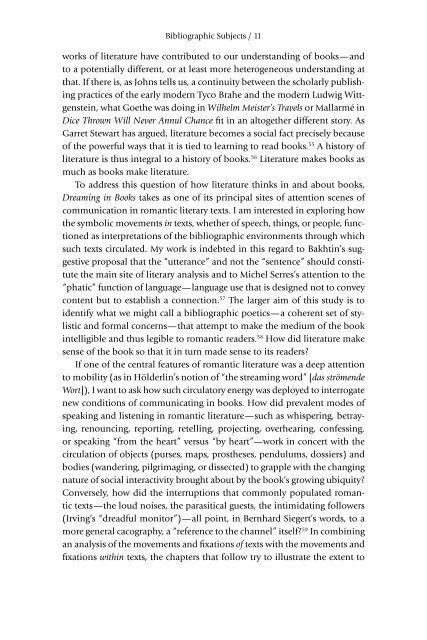Dreaming in Books - uncopy
Dreaming in Books - uncopy
Dreaming in Books - uncopy
You also want an ePaper? Increase the reach of your titles
YUMPU automatically turns print PDFs into web optimized ePapers that Google loves.
Bibliographic Subjects / 11<br />
works of literature have contributed to our understand<strong>in</strong>g of books—and<br />
to a potentially different, or at least more heterogeneous understand<strong>in</strong>g at<br />
that. If there is, as Johns tells us, a cont<strong>in</strong>uity between the scholarly publish<strong>in</strong>g<br />
practices of the early modern Tyco Brahe and the modern Ludwig Wittgenste<strong>in</strong>,<br />
what Goethe was do<strong>in</strong>g <strong>in</strong> Wilhelm Meister’s Travels or Mallarmé <strong>in</strong><br />
Dice Thrown Will Never Annul Chance fi t <strong>in</strong> an altogether different story. As<br />
Garret Stewart has argued, literature becomes a social fact precisely because<br />
of the powerful ways that it is tied to learn<strong>in</strong>g to read books. 55 A history of<br />
literature is thus <strong>in</strong>tegral to a history of books. 56 Literature makes books as<br />
much as books make literature.<br />
To address this question of how literature th<strong>in</strong>ks <strong>in</strong> and about books,<br />
<strong>Dream<strong>in</strong>g</strong> <strong>in</strong> <strong>Books</strong> takes as one of its pr<strong>in</strong>cipal sites of attention scenes of<br />
communication <strong>in</strong> romantic literary texts. I am <strong>in</strong>terested <strong>in</strong> explor<strong>in</strong>g how<br />
the symbolic movements <strong>in</strong> texts, whether of speech, th<strong>in</strong>gs, or people, functioned<br />
as <strong>in</strong>terpretations of the bibliographic environments through which<br />
such texts circulated. My work is <strong>in</strong>debted <strong>in</strong> this regard to Bakht<strong>in</strong>’s suggestive<br />
proposal that the “utterance” and not the “sentence” should constitute<br />
the ma<strong>in</strong> site of literary analysis and to Michel Serres’s attention to the<br />
“phatic” function of language—language use that is designed not to convey<br />
content but to establish a connection. 57 The larger aim of this study is to<br />
identify what we might call a bibliographic poetics—a coherent set of stylistic<br />
and formal concerns—that attempt to make the medium of the book<br />
<strong>in</strong>telligible and thus legible to romantic readers. 58 How did literature make<br />
sense of the book so that it <strong>in</strong> turn made sense to its readers?<br />
If one of the central features of romantic literature was a deep attention<br />
to mobility (as <strong>in</strong> Hölderl<strong>in</strong>’s notion of “the stream<strong>in</strong>g word” [das strömende<br />
Wort]), I want to ask how such circulatory energy was deployed to <strong>in</strong>terrogate<br />
new conditions of communicat<strong>in</strong>g <strong>in</strong> books. How did prevalent modes of<br />
speak<strong>in</strong>g and listen<strong>in</strong>g <strong>in</strong> romantic literature—such as whisper<strong>in</strong>g, betray<strong>in</strong>g,<br />
renounc<strong>in</strong>g, report<strong>in</strong>g, retell<strong>in</strong>g, project<strong>in</strong>g, overhear<strong>in</strong>g, confess<strong>in</strong>g,<br />
or speak<strong>in</strong>g “from the heart” versus “by heart”—work <strong>in</strong> concert with the<br />
circulation of objects (purses, maps, prostheses, pendulums, dossiers) and<br />
bodies (wander<strong>in</strong>g, pilgrimag<strong>in</strong>g, or dissected) to grapple with the chang<strong>in</strong>g<br />
nature of social <strong>in</strong>teractivity brought about by the book’s grow<strong>in</strong>g ubiquity?<br />
Conversely, how did the <strong>in</strong>terruptions that commonly populated romantic<br />
texts—the loud noises, the parasitical guests, the <strong>in</strong>timidat<strong>in</strong>g followers<br />
(Irv<strong>in</strong>g’s “dreadful monitor”)—all po<strong>in</strong>t, <strong>in</strong> Bernhard Siegert’s words, to a<br />
more general cacography, a “reference to the channel” itself? 59 In comb<strong>in</strong><strong>in</strong>g<br />
an analysis of the movements and fi xations of texts with the movements and<br />
fi xations with<strong>in</strong> texts, the chapters that follow try to illustrate the extent to








